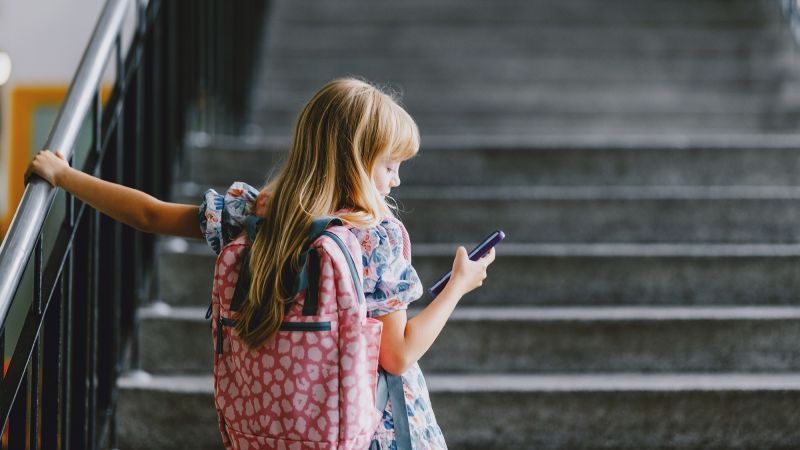Kara Alaimo is a professor of communication at Fairleigh Dickinson University. Her book “Over the Influence: Why Social Media Is Toxic for Women and Girls — And How We Can Take It Back” was published in 2024 by Alcove Press.
Most kids are getting smartphones at much younger ages than many experts recommend, according to new research.
A majority of parents of kids ages 11 to 12 said their child has a smartphone, a Pew Research Center survey published October 8 found. However, many experts, myself included, recommend holding off on allowing kids to use social media — which having a smartphone enables — until age 16.
The most-cited reason for letting kids have phones is so parents can get in contact with them, according to the survey conducted in May of over 3,000 parents of children ages 12 and younger.
Smartphones aren’t the only thing kids are using at a young age. Overall screen time also is an issue, with 85% of parents saying their children watch YouTube, including more parents of children younger than age 2 than in 2020.
The findings shed new light on “just how prevalent tech use is for kids today, including for some of the youngest kids,” said Colleen McClain, senior researcher at the Pew Research Center and the study’s lead author. “The degree to which screens start young is a very striking finding.”
While most parents — 86% — said ensuring their children’s screen time is reasonable is a daily priority for them, 47% of parents of 8- to 12-year-olds said they could do a better job handling their kids’ screen time.
Part of the problem seems to be parents sticking to the rules they set for their kids. While 86% of parents said they had rules about their children’s screen use, just 19% always enforce them.
Parents don’t seem happy about how things are going, with 80% saying the harms outweigh the benefits their kids get from social media.
While McClain said one limitation of the survey is that it queried parents (not kids), the research suggests it’s worth rethinking our approaches to children’s technology use.
Here’s how to do it — while still staying connected to your children and even keeping them happy.
As a mom, I too want to stay in touch with my daughter so if she gets hurt or feels uncomfortable on a playdate, she can call me. That’s why when I speak to parent groups about how to handle kids’ social media use, I remind everyone that there are ways to stay in contact without giving children smartphones.
Parents can get their kids a “dumbphone” — a flip phone that can be used for talking and texting but not social media use. That’s important, because social media is where kids can be exposed to incredibly toxic content and connect with adult predators.
You can also consider getting your kids a watch that allows them to call, text and even track their real-time locations.
In my home, I have a “family device” that I give my oldest child to take when she goes to an activity without parents so she can reach us. But it doesn’t officially belong to her, and she uses it only to stay in contact with family members.
With so many tweens now on smartphones, peer pressure is another problem. Parents constantly tell me that because their kids’ friends have phones, they worry about depriving their children of social connections and invitations if they don’t get one.
That’s why we need to talk to the parents of our kids’ friends while they’re still young, to agree collectively to hold off on getting our kids smartphones until they’re old enough to use them responsibly. My oldest child is still in elementary school, but I’m already doing this now.
So is Lauren Tetenbaum, a New York-based psychotherapist to moms and a parent of two elementary school kids. She said that in her community parents are even discussing landlines as a way for kids to communicate.
These conversations are important because 11– and 12-year-olds aren’t old enough to handle the pressures that come with using social media. Research has found that using social media around the time kids go through puberty is associated with lower life satisfaction a year later. That’s why I don’t plan to get my children their own smartphones until they are 16.
Of course, many kids got smartphones before parents knew about all this research. If that’s the case, they can protect their children with strong rules about when and how phones are used.
I suggest the rules for how kids use smartphones include plans for ensuring they get enough time for uninterrupted sleep, homework, extracurricular activities, and face-to-face time with friends and family members. And note that if the rules are constantly being broken, kids realize they don’t have to follow them. If that’s happening, update the rules and stick to them.
You might agree that kids won’t use their phones when they are doing homework unless they need to ask a friend a question or use the internet for research. In that case, they’ll turn off notifications from all apps and not check anything else on their phones.
Develop the rules with your kids, Tetenbaum said. “When kids give their input, it’s more realistic to stick to the rules,” she said. Ask them how they want to use their devices and what they think is fair.
“It’s key to consistently remind your kids that the devices belong to you as the grownup,” Tetenbaum said via email. That means you can review what they’re doing on them at any time.
Parents should also try to set rules for their own social media use.
“Modeling is also really important,” Tetenbaum said. “Try not to be on your phone at meals with your kids, or if you are using it to check what’s on the agenda for the day, say so.”
If you feel like your children’s social media use isn’t working, try giving them other attractive options. It’s never too late to make things better. Parents can say something such as “yesterday was a rainy day and we used a lot of screen time,” Tetenbaum said. “Let’s make today an outdoor day or spend time reading or doing something else.” Then ask your kids what they want to do.
Despite the challenges we’re up against, we can stay connected to our young kids — and allow them to connect with their friends — without smartphones. Once kids do get them, we can manage their use with smart strategies.
Get inspired by a weekly roundup on living well, made simple. Sign up for CNN’s Life, But Better newsletter for information and tools designed to improve your well-being.


